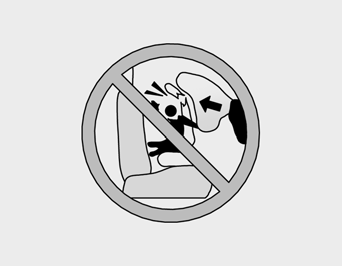SRS Care
The SRS is virtually maintenance-free and there are no parts you can safely service by yourself. If the SRS "AIR BAG" warning light does not illuminate, or continuously remains on, have your vehicle immediately inspected by your Hyundai dealer.
Any work on the SRS system, such as removing, installing, repairing, or any work on the steering wheel must be performed by a qualified Hyundai technician. Improper handling of the SRS system may result in serious personal injury.

WARNING:
o Do not install a child restraint system in the front passenger seat position. A child restraint system must never be placed in the front seat. The infant or child could be severely injured by an airbag deployment in case of an accident.
o Modification to SRS components or wiring, including the addition of any kind of badges to the pad covers or modifications to the body structure, can adversely affect SRS performance and lead to possible injury.
o For cleaning the airbag pad covers, use only a soft, dry cloth or one which has been moistened with plain water. Solvents or cleaners could adversely affect the airbag covers and proper deployment of the system.
WARNING:
o No objects should be placed over or near the airbag modules on the steering wheel, instrument panel, and the front passenger's panel above the glove box, because any such object could cause harm if the vehicle is in a crash severe enough to cause the airbags to inflate.
o If the airbags inflate, they must be replaced by an authorized Hyundai dealer.
o Do not tamper with or disconnect SRS wiring, or other components of the SRS system. Doing so could result in injury, due to accidental inflation of the airbags or by rendering the SRS inoperative.
o If components of the airbag system must be discarded, or if the vehicle must be scrapped, certain safety precautions must be observed. Your Hyundai dealer knows these precautions and can give you the necessary information. Failure to follow these precautions and procedures could increase the risk of personal injury.
o If your car was flooded and has soaked carpeting or there is water on the floor, do not start the engine; have the car towed to an authorized Hyundai dealer.
Additional Safety Precautions
o Never let passengers ride in the cargo area (trunk) or on top of a folded-down back seat. All occupants should sit upright, fully back in their seats with their seat belts on and their feet on the floor.
o Passengers should not move out of or change seats while the vehicle is moving. A passenger who is not wearing a seat belt during a crash or emergency stop can be thrown against the inside of the vehicle, against other occupants, or out of the vehicle.
o Each seat belt is designed to restrain one occupant. If more than one person uses the same seat belt, they could be seriously injured or killed in a collision.
o Do not use any accessories on seat belts. Devices claiming to improve occupant comfort or reposition the seat belt can reduce the protection provided by the seat belt and increase the chance of serious injury in a crash.
o Passengers should not place hard or sharp objects between themselves and the airbags. Carrying hard or sharp objects on your lap or in your mouth can result in injuries if an airbag inflates.
o Keep occupants away from the airbag covers. All occupants should sit upright, fully back in their seats with their seat belts on and their feet on the floor. If occupants are too close to the airbag covers, they could be injured if the airbags inflate.
o Do not attach or place objects on or near the airbag covers. Any object attached to or placed on the front or side impact airbag covers could interfere with the proper operation of the airbags.
o Do not modify the front seats. Modification of the front seats could interfere with the operation of the supplemental restraint system sensing components or side impact airbags.
o Do not place items under the front seats. Placing items under the front seats could interfere with the operation of the supplemental restraint system sensing components and wiring harnesses.
o Never hold an infant or child on your lap. The infant or child could be seriously injured or killed in the event of a crash. All infants and children should be properly restrained in appropriate child safety seats or seat belts in the rear seat.
WARNING:
o Sitting improperly or out of position can cause occupants to be shifted too close to a deploying airbag, strike the interior structure or be thrown from the vehicle resulting in serious injury or death.
o Always sit upright with the seatback in an upright position, centered on the seat cushion with your seat belt on, legs comfortably extended and your feet on the floor.
Adding Equipment to or Modifying Your Airbag-Equipped Vehicle.
If you modify your vehicle by changing your vehicle's frame, bumper system, front end or side sheet metal or ride height, this may adversely affect the operation of your vehicle's airbag system.
See also:
Driving in the rain
Rain and wet roads can make driving dangerous, especially if you’re not prepared
for the slick pavement. Here are a few things to consider when driving in the rain:
• A heavy rainfall will make it ...
Accent in the Market
The Accent is a winning formula of attractive design meeting extreme value.
The fact that it drives well and gets class-leading mileage only cements it at
the top of the subcompact class … for now ...
Recommended Engine Coolant
When adding coolant, use only deionized water or soft water for your vehicle
and never mix hard water in the coolant filled at the factory. An improper coolant
mixture can result in serious malfun ...


